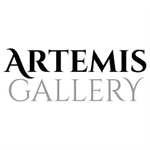Roman Bronze Applique Bust - Alexander the Great
Lot 1a
About Seller
Artemis Fine Arts
686 S Taylor Ave, Ste 106
Louisville, CO 80027
United States
Selling antiquities, ancient and ethnographic art online since 1993, Artemis Gallery specializes in Classical Antiquities (Egyptian, Greek, Roman, Near Eastern), Asian, Pre-Columbian, African / Tribal / Oceanographic art. Our extensive inventory includes pottery, stone, metal, wood, glass and textil...Read more
Categories
Estimate:
$14,000 - $21,000
Absentee vs Live bid
Two ways to bid:
- Leave a max absentee bid and the platform will bid on your behalf up to your maximum bid during the live auction.
- Bid live during the auction and your bids will be submitted real-time to the auctioneer.
Bid Increments
| Price | Bid Increment |
|---|---|
| $0 | $25 |
| $300 | $50 |
| $1,000 | $100 |
| $2,000 | $250 |
| $5,000 | $500 |
| $10,000 | $1,000 |
| $20,000 | $2,500 |
| $50,000 | $5,000 |
| $100,000 | $10,000 |
| $200,000 | $20,000 |
About Auction
By Artemis Fine Arts
Mar 20, 2025
Set Reminder
2025-03-20 10:00:00
2025-03-20 10:00:00
America/New_York
Bidsquare
Bidsquare : Exceptional Finds | Ancient, Asian, Ethno, Fine Art
https://www.bidsquare.com/auctions/artemis-gallery/exceptional-finds-ancient-asian-ethno-fine-art-18151
Explore a world of classical antiquities and ethnographic masterpieces, with treasures from every corner of the globe. Discover Egyptian relics, Greek and Roman artifacts, Etruscan elegance, Near Eastern wonders, and Asian heritage. Marvel at Pre-Columbian marvels, Native American artistry, African tribal expressions, and Oceanic cultural gems. Spanish Colonial legacies, Russian craftsmanship, and a spectrum of fine and visual arts await, offering a captivating journey through history and artistry, connecting cultures across time. Artemis Fine Arts info@artemisgallery.com
Explore a world of classical antiquities and ethnographic masterpieces, with treasures from every corner of the globe. Discover Egyptian relics, Greek and Roman artifacts, Etruscan elegance, Near Eastern wonders, and Asian heritage. Marvel at Pre-Columbian marvels, Native American artistry, African tribal expressions, and Oceanic cultural gems. Spanish Colonial legacies, Russian craftsmanship, and a spectrum of fine and visual arts await, offering a captivating journey through history and artistry, connecting cultures across time. Artemis Fine Arts info@artemisgallery.com
- Lot Description
Roman, Imperial period, ca. 2nd century CE. A breathtaking bronze applique bust of the famed conqueror Alexander the Great, bare-chested and characteristically leonine with hair dramatically upswept in an anastole. Gazing to his right, the slight upward tilt of his head combined with his huge, almond-shaped eyes conveys an engaging yet commanding stare. Note his youthful features and idealized beauty reminiscent of Apollo, perhaps a reference to the gold coin-portraits of the god issued by King Philip II unmistakably rendered in Alexander's likeness or to Alexander's own claims of divine paternity as the son of Zeus, who was also the father of Apollo. This resemblance to a deity reinforces the syncretic nature of ancient art, where mortal leaders were elevated to divine status through visual cues, aligning them with gods known for attributes such as wisdom, power, and beauty while also immortalizing them through art. Size: 2.5" L x 5" W x 6.1" H (6.4 cm x 12.7 cm x 15.5 cm); 8.5" H (21.6 cm) on included custom stand.
Such busts as this example were produced during the Roman period, reflecting the Romans' admiration for Alexander and their adoption of Hellenistic artistic traditions. They symbolized the transmission of Greek culture to Rome and the enduring legacy of Alexander as a model of leadership and military genius. Such busts were produced during the Roman period, reflecting the Romans' admiration for Alexander and their adoption of Hellenistic artistic traditions. They symbolized the transmission of Greek culture to Rome and the enduring legacy of Alexander as a model of leadership and military genius. Crafted with precision, this bronze showcases the technical skill of Roman bronze sculptors and their ability to capture nuanced expressions and lifelike details, blending Greek idealism with Roman realism.
Surviving portraits of Alexander the Great are noteworthy for their wide range of styles employed to portray his unique physiognomy. Ancient sources recount that Alexander the Great issued a decree designating specific artists for his portrayal: Lysippos was to sculpt his image in bronze, Apelles to paint his likeness, and Pyrgoteles to engrave his image on gems (see D. Pandermalis, Alexander the Great: Treasures from an Epic Era of Hellenism, p. 15). Several bronze portraits were commissioned, including a renowned standing figure of Alexander holding a lance. Although the original has not survived, Plutarch (On the Fortune of Alexander, 2.2) describes the statue's distinctive upward-tilted head, which conveyed an intense and penetrating gaze. These portraits also typically featured his iconic leonine hair styled with the characteristic anastole, a parting at the center of his forehead.
Another celebrated depiction showed Alexander on horseback alongside twenty-five of his soldiers, erected at the sanctuary of Zeus in Dion at the base of Mount Olympus. This statue was later looted by Roman general Q. Caecilius Metellus and transported to Rome in 146 BCE. Its design is reflected in a small statuette from Herculaneum, now housed in Naples (see no. 4, op. cit.).
The Romans' admiration for prominent historical figures, combined with their fervent demand for ancient art, ensured Alexander's likeness remained highly sought after during the Imperial period. Life-sized replicas were created in both bronze and marble, alongside smaller-scale pieces, such as the bronze head featured here, which may have originally been attached to a separately crafted torso.
Published: J. Eisenberg, "Art of the Ancient World" Vol. XXIII, 2012, no. 53 and Vol. XXVIII, 2017, no. 56.
Provenance: ex-Royal Athena Galleries, New York City, New York, USA; ex-B.H.S. collection, St. Petersberg, Florida, USA, from the 1950s - early 1970s
All items legal to buy/sell under U.S. Statute covering cultural patrimony Code 2600, CHAPTER 14, and are guaranteed to be as described or your money back.
A Certificate of Authenticity will accompany all winning bids.
We ship worldwide and handle all shipping in-house for your convenience.
SHIPPING EXCEPTIONS: Due to customs clearance issues, we are unable to ship to Germany, Switzerland and Australia. If you live in Germany, Switzerland or Australia, you will need to provide an alternate shipping destination, or we will not be able to complete your purchase. In addition, please note that we are unable to ship ancient items back to the original country of origin (Egyptian to Egypt, Greek to Greece, etc.)
PAYMENT EXCEPTION: Unless a known customer of Artemis, payment for all gold / precious metal / gem lots must be made via Bank Wire Transfer or Certified Bank Check/Money Order, no exceptions.
#190828Professional restoration to chest and in some small areas of the face; all done very well and only noticeable from verso. Cleaned in modern times with some areas of resurfacing, but otherwise excellent with an impressive presentation and remarkable detail. Rich green patina to surface and nice azurite deposits on interior.Condition
- Shipping Info
-
All shipping is handled in-house for your convenience. Your invoice from Artemis Gallery will include shipping calculation instructions. If in doubt, please inquire BEFORE bidding for estimated shipping costs for individual items.
-
- Buyer's Premium



 EUR
EUR CAD
CAD AUD
AUD GBP
GBP MXN
MXN HKD
HKD CNY
CNY MYR
MYR SEK
SEK SGD
SGD CHF
CHF THB
THB














